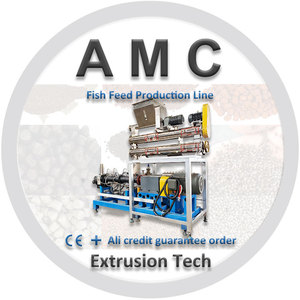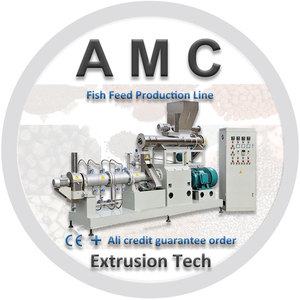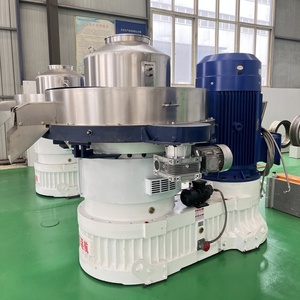
All categories
Featured selections
Trade Assurance
Buyer Central
Help Center
Get the app
Become a supplier

(58897 products available)
































Fish pellet machines are available in various sizes and types, suitable for small and large production needs. These machines can produce different sized pellets to meet diverse dietary requirements for fish.
Low production costs and operational simplicity are distinguishing features of the single screw extruder. It uses a single screw to mix and push the ingredients through a barrel and die to produce pellets. Such an extruder is especially recommended for small- to medium-sized fish feed production businesses.
The strength and homogeneity of the feed produced by a double screw extruder are its main advantages. Two screws facilitate better mixing and cooking, allowing for more complex feed formulations. Larger scale operations that require higher output rates would suit a double screw extruder.
A flat die pellet mill is the machines' simplicity and low cost, especially for producing fish feed from agricultural by-products. In this type, the feed ingredients are compressed into shallow molds, or dies, on a flat, horizontal surface, producing pellets. Small-scale production or on-farm feed milling would require a flat die pellet mill.
Compared to flat die mills, ring die pellet mills are more suited for large-scale industrial production due to their high output. The pellets come from pressing feed through a cylindrical die. High-efficiency machines, like these, produce uniform, high-quality pellets, preferably for large commercial entities.
When choosing a type of fish pellet machine, buyers must consider the scale of production, budget, and the type of feed they intend to produce. Each category has particular features that fit certain manufacturing purposes.
A floating fish feed machine, which can also produce sinking and subsurface pellets, has several key components that define its functionality and performance.
Fish pellet machines use high-quality, wear-resistant materials to ensure durability. Pellets go through combination, propulsion, and cooking processes in the extrusion chamber. As a result, the materials employed here must be capable of tolerating elevated temperatures and pressures. Common materials include stainless steel and alloy steel for the screw and barrel to resist wear and corrosion.
The kind of die used in the machine, which defines the pellet size and form, is another significant feature. For varied fish species and developmental stages, fish feed requires various pellet sizes. Most fish pellet machines have interchangeable dies, so users can adjust the size of the pellets as per their requirements.
Fish pellet machines have incorporated heating systems into the process to improve feed exhaustion. Steam injection often helps cook the ingredients, enhancing their nutritional value. Conversely, certain systems use cooling devices to lower the temperature of the extruded pellets, ensuring better stability and storage capabilities.
Floating fish feed machines can be small or large and run on various electric motor or diesel engine types. Large-scale operations mostly use electric motors because they are efficient and easy to operate. However, small or remote operations have the motor replaced with a diesel engine, which offers flexibility and independence from electric power.
Buyers must consider the essential aspects of a fish pellet machine when selecting one. These aspects include size, material quality, die types, heating and cooling systems, and power sources. Meanwhile, they all affect the machine's performance and sustainability.
Several sectors of business use fish pellet machines, especially in aquaculture and the animal feed enterprises. People often inquire about how commonly people use these machines and their impact on feeding systems.
Advanced feed solutions are being generated for aquaculture using fish pellet machines. Aquaculture businesses produce highly digestible, nutritionally dense feed using the floating or sinking characteristics of pellets and their potential to easily measure, transport, and store them for fish farming. Some pellet machines also generate feed that is more efficient for fish farming businesses to enhance growth and reduce feed waste.
Fish feed in various pellet forms makes an ingredient in some high-end fish foods. Companies producing aquarium fish food employ fish pellet machines to produce diverse pellet sizes and textures for various fish species. These machines make it possible to innovate new formulations and improve the quality of fish food products.
Large quantities of fish feed |are produced from23622252 fish pellet machines, which are then exported by the transformer. Nations trade aquatic feeds, moving pellets that meet particular market needs. Efficient feed production processes that produce high-quality, stable pellets and support international transportation are vital to exporters and importers.
fish food making machinesare utilized by feed manufacturing businesses to make poultry and livestock feed. In the production of compound feeds for farm animals, manufacturers frequently use fish meal as an ingredient. Manufacturers producing extruded feed for diverse animal species use fish pellet machines to produce pellets of varied sizes and forms.
Fish pellet machines can produce customized feeds for various species, enhancing growth and improving feed conversion rates in aquatic farming. They have established themselves as essential instruments in industries that require innovative, high-quality feed formulations, going beyond the boundaries of aquaculture.
Some main factors to consider when purchasing a fish pellet machine influence its profitability and productivity. Furthermore, understanding these factors aids fish pellet machine buyers in making informed decisions when sourcing pellet machines.
The machine's productivity must meet the feed volume an enterprise anticipates producing. small fish feed machinesare appropriate for small-scale operations producing low feed volumes daily. In contrast, more extensive, industrial-grade machines are for larger businesses requiring high feed turnover rates.
Given the increasing energy costs, choosing a machine that runs efficiently, especially electric or diesel-powered ones, is important. Machines with high energy efficiency lower production costs by reducing the power needed to sustain operations.
The feedstuff flexibility for producing pellets in a fish pellet machine is another essential consideration. Machines capable of processing diverse raw materials, such as grains, oilseeds, and fish by-products, allow businesses to develop a wider variety of feeds, catering to different species' nutritional requirements. Such machines also promote sustainability by encouraging the use of local or available resources.
The machine comes in various price categories, from basic models to high-tech manufacturing systems. Recognizing why a specific machine class is affordable helps to ensure that the money is well spent. With affordable models, the up-front cost may be lower, but if the business requires high productivity, they might need to consider a more expensive model.
It is vital to also consider the availability of technical help and machine servicing, especially for buyers of industrial machines. More manufacturers provide support to their customers, including warranties, maintenance services, and readily available spare parts. A provider with a reputation for high-quality after-sale support can ensure the business's sustenance.
A1: Moisture content significantly affects pellet quality. The moisture level in the feedstock must be right before extrusion. Overly high moisture causes the pellets to disintegrate, while excessively low moisture leads to poor feedstock exhaustion and machine wear.
A2:Most fish pellet machines have interchangeable dies that allow users to easily switch between pellets of different sizes. This flexibility is essential for accommodating various species and growth stages in aquaculture. Using different dies, clients can adjust the pellet size without needing additional machinery, which is cost-effective and efficient.
A3:Main fish pellet machine maintenance practices include regular checks on the screw and die for wear and tear, lubrication of moving parts, and cleaning the extruder to remove feed residue. Routine inspections and parts replacements before they wear out guarantee high productivity and minimum chances of machine breakdown.
A4:Current trends mainly emphasize energy efficiency and automation. Modern machines automatically adjust parameters like moisture content and temperature to enhance feed exhaustion.
A5:Some small-scale fish pellet machines, powered with motors or diesel, are portable, allowing users to produce feed on different farms or locations. Such mobility benefits operations without power accessibility, as they can manufacture feed in situ using locally sourced materials.